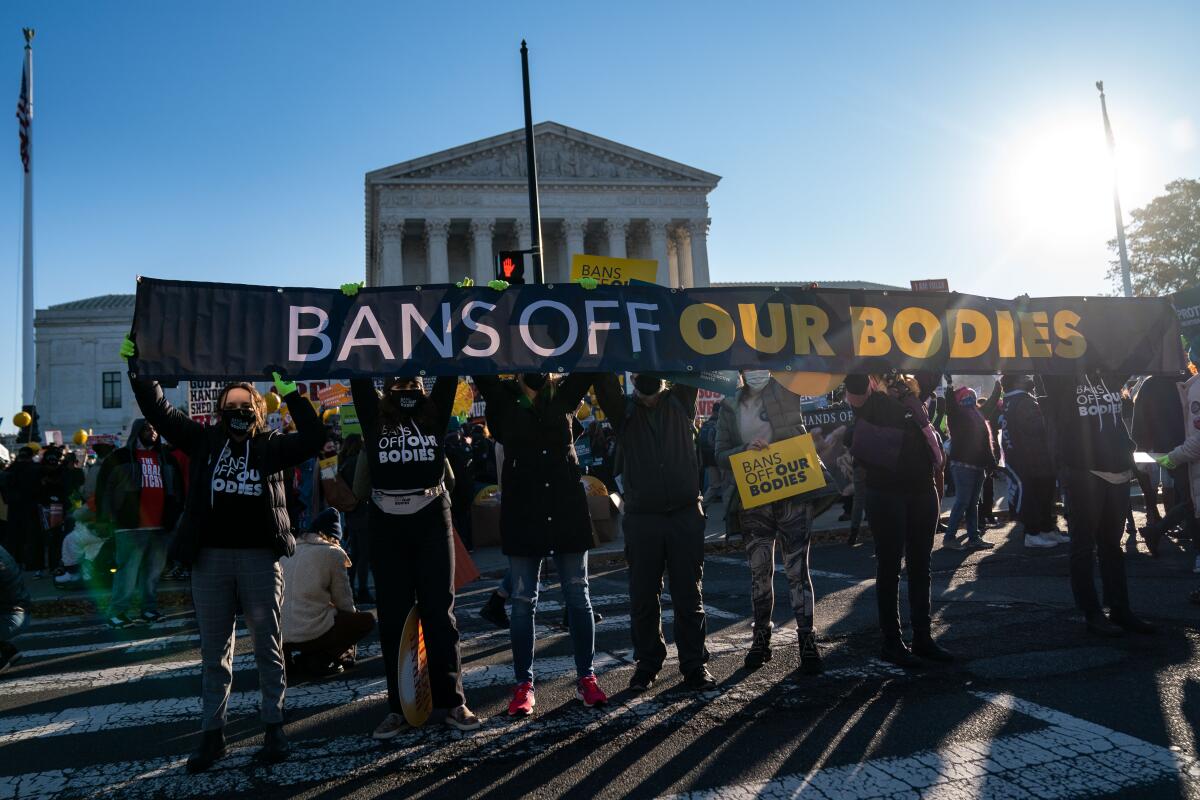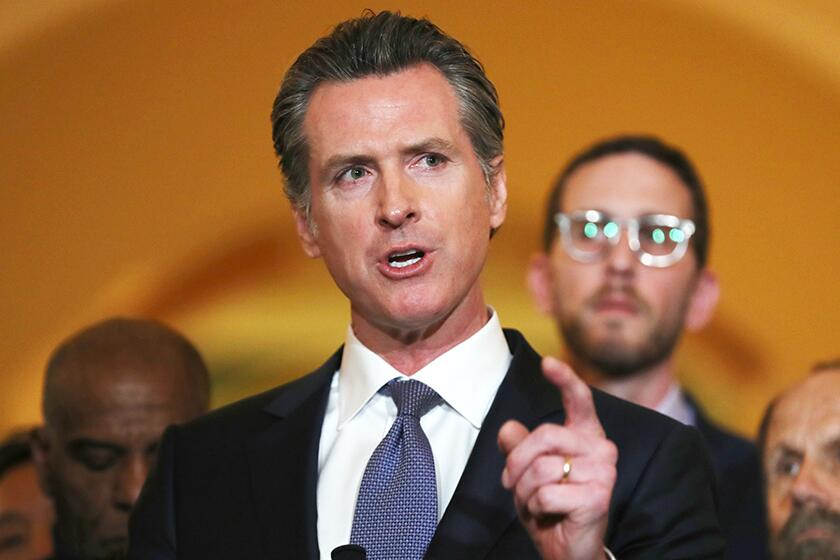Supreme Court leaves Texas abortion law in effect, allows only a narrow challenge to it

- Share via
WASHINGTON — A divided Supreme Court declined Friday to block a Texas law that has banned most abortions there and left doctors and abortion clinics with few legal options for challenging it.
The Texas law SB 8 makes abortions illegal after six weeks of a pregnancy and authorizes private lawsuits in Texas courts against anyone who violates it.
Abortion-rights advocates said the law was clearly unconstitutional, and they sued state judges and their clerks as well as the state attorney general, seeking a federal court ruling that would freeze the law and shield doctors and clinics.
But the court’s conservative majority rejected most of what they sought on Friday. The justices said state judges and their staffs cannot be sued, nor can the state attorney general, who has no direct role in enforcing the law. They agreed a suit could name four state officials who license medical professionals. But stopping them would not stop the state law, lawyers said.
“This is a dark day for abortion patients and for physicians and providers, “ said Marc Hearron, an attorney for the Center for Reproductive Rights who brought the case to the high court. “It is also a dark day for anyone who cares about constitutional rights.”
Chief Justice John G. Roberts Jr. and the three liberals mostly dissented, saying the court should have gone further to allow an effective challenge to the law.
Roberts said Texas sought to “nullify this court’s rulings” that held women have a right to choose abortion. “It is the role of the Supreme Court in our constitutional system that is at stake,” he added.
Justice Sonia Sotomayor, speaking in dissent, said the “court should have put an end to this madness months ago, before SB 8 first went into effect. It failed to do so then, and it fails again today.”
The 5-4 split in the Texas case shows a deepening divide over abortion. At times over the last year, it appeared as though Justices Brett M. Kavanaugh and Amy Coney Barrett might go along with the chief justice in taking a go-slow approach to the abortion controversy.
But in September, they stood aside and allowed the Texas law to take effect. And during last week’s argument in a Mississippi case, they sounded ready to join three other conservatives to overturn Roe vs. Wade and the right to abortion.
As the politics of abortion shifted in Texas, so did Republican Gov. Greg Abbott’s position.
In a related case, the court on Friday also tossed out the appeal brought by the Biden administration seeking to halt the Texas law.
At issue in the Texas case was whether a federal judge could block the state’s abortion law as unconstitutional. Because of the unusual enforcement mechanism of the law, it was not clear who could be sued. The law is not enforced by state officials but instead through private lawsuits. The threat of lawsuits has shut down or severely restricted most abortion providers in Texas.
Speaking for the fractured court on Friday, Justice Neil M. Gorsuch said abortion providers should pursue their challenges in the Texas state courts.
“This court has never recognized an unqualified right to pre-enforcement review of constitutional claims in federal court,” he wrote.
Gorsuch said state judges and their clerks are immune from being sued by the abortion providers, and the state attorney general has no role in enforcing the law.
But he said four state officials who license medical professionals may be sued because they “may or must take enforcement actions” against doctors who violate state law.
“Accordingly, we hold that sovereign immunity does not bar the petitioners’ suit against these named defendants at the motion to dismiss stage,” he wrote in Whole Woman’s Health vs. Jackson.
Eight justices agreed on this point, all but Justice Clarence Thomas. He would have dismissed all the challenges to the Texas law.
Friday’s ruling means abortion-rights advocates may go back to a federal judge in Austin and urge him to block the state law on the grounds it violates the Constitution. But it is not clear the judge could hand down a broad order halting the state law.
And any such decision is certain to be challenged in the conservative 5th Circuit Court in New Orleans. Twice already, the appeals court has halted challenges to the Texas abortion ban.
Nancy Northup, president of the Center for Reproductive Rights, said it “is stunning that the Supreme Court has essentially said that federal courts cannot stop this bounty-hunter scheme enacted to blatantly deny Texans their constitutional right to abortion. For 100 days now, this six-week ban has been in effect, and today’s ruling means there is no end in sight.”
Marjorie Dannenfelser, president of the national antiabortion group Susan B. Anthony List, welcomed the ruling.
“We celebrate that the Texas Heartbeat Act will remain in effect, saving the lives of unborn children and protecting mothers while litigation continues in lower courts,” she said. Citing last week’s arguments in the Mississippi case, she said “we have great hope that the court will return the issue back to the people to decide through their elected representatives, letting democracy and consensus prevail.”
When the justices heard arguments in the Texas case last month, Kavanaugh and Barrett sounded as though they would vote to block the law, or at least clear the way for a successful challenge. Instead, they joined with the more conservative justices to allow only the narrowest of challenges.
This was similar to the court’s approach in September.
In that earlier order, the court said the law raised “complex and novel ... procedural questions” because officials had no direct role in enforcing the ban on most abortions.
Their decision drew sharp criticism and may well have prompted at least some justices to reconsider the matter. To many, it appeared the new conservative majority had allowed the nation’s largest red state to ignore nearly 50 years of court precedents that held abortion was a constitutional right.
Responding to their initial rebuff, lawyers for the abortion providers went back to the high court and urged the justices to fast-track a hearing on the procedural questions raised by a law that is enforced through what they called a private bounty scheme.
The court heard arguments from both sides on Nov. 1, when it appeared most of the justices were prepared to block the law. Kavanaugh said gun rights and religious liberty could be put in doubt if the court allowed states to use Texas-style lawsuits as a means to nullify constitutional rights.
But in the end, Kavanaugh and Barrett were not prepared to join an opinion that could have blocked the Texas law.
More to Read
Get the L.A. Times Politics newsletter
Deeply reported insights into legislation, politics and policy from Sacramento, Washington and beyond. In your inbox twice per week.
You may occasionally receive promotional content from the Los Angeles Times.












